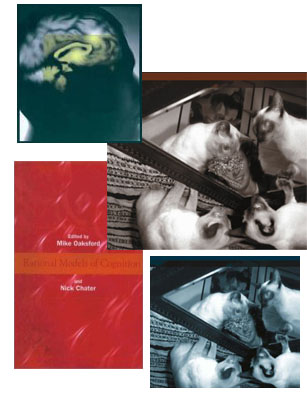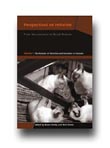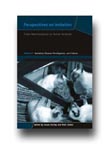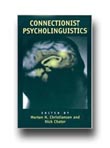| Papers
organised by theme |
|
|
|
|
| Reasoning
and Decision Making |
back
to top 5
|
|
[PDF]
Stewart, N., Chater, N. & Brown, G. D. A. (2006). Decision
by sampling. Cognitive Psychology. 53, 1-26.
[PDF]
Vlaev, I. & Chater, N. (2006). Game Relativity: How
Context Influences Strategic Decision Making. Journal of Experimental
Psychology: Learning, Memory & Cognition, 32, 131-149.
[PDF]
Chater, N., Heit, E. & Oaksford, M. (2004). Reasoning.
In K. Lamberts & R. Goldstone (eds.) Handbook of Cognition
(pp. 297-320). London: Sage Publications.
[PDF]
Chater, N., & Oaksford, M. (2004). Rationality,
rational analysis and human reasoning. In K. Manktelow &
M. C. Chung (Ed.), Reasoning: History and philosophy. Hove,
Sussex: Psychology Press.
[PDF]
Moore, S. & Chater, N. (2003). The Influence of
Affect on Risky Behavior: From the Lab to Real World Financial
Behavior. In R. Alterman & D. Kirsh (Eds.). Proceedings
of the 23rd Annual Conference of the Cognitive Science Society
(6 pages).
[PDF]
Vlaev, I. & Chater, N. (2003). Toward a cognitive
game theory. Behavioral and Brain Sciences, 26, 178-179.
[PDF]
Reimers, S., Stewart, N. & Chater, N. (2003). Choice
set options affect the valuation of risky prospects. In R. Alterman
& D. Kirsh (Eds.). Proceedings of the 23rd Annual Conference
of the Cognitive Science Society (6 pages).
[PDF]
Vlaev, I. & Chater, N. (2003). Effects of Sequential
Context on Judgments and Decisions in Prisoner's Dilemma Game.
In R. Alterman & D. Kirsh (Eds.). Proceedings of the 23rd
Annual Conference of the Cognitive Science Society (6 pages).
[PDF]
Chater, N., Oaksford, M., Nakisa, R. & Redington,
M. (2003). Fast, frugal and rational: How rational norms explain
behavior. Organizational Behavior and Human Decision Processes,
90, 63-86.
[PDF]
Stewart, N., Chater, N., Stott, H. P., & Reimers,
S. (2003). Prospect relativity: How choice options influence
decision under risk. Journal of Experimental Psychology: General,
132, 23-46.
[PDF]
Oaksford, M. & Chater, N. (2003). Computational
levels and conditional inference: Reply to Schroyens and Schaeken
(2003). Journal of Experimental Psychology: Learning, Memory
& Cognition, 29, 150-156.
[PDF]
Oaksford, M., & Chater, N. (2003). Conditional probability
and the cognitive science of conditional reasoning. Mind &
Language, 18, 359-379.
[PDF]
Oaksford, M., & Chater, N. (2003). Modelling probabilistic
effects in conditional inference: Validating search or conditional
probability? Psychologica, 32, 217-242.
[PDF]
Oaksford, M., & Chater, N. (2003). Probabilities
and pragmatics in conditional inference: Suppression and order
effects. In D. Hardman, & L. Macchi (Eds.), Reasoning and
Decision Making (pp. 95-122). London: Wiley.
[PDF]
Chater, N. & Oaksford (2003) Rational models of
cognition. In L. Nadel (Ed.) Encyclopedia of Cognitive Science,
Vol 3 (pp. 826-829). London: Macmillan Press.
[PDF]
Oaksford, M., Roberts, L. & Chater, N. (2002). Relative
informativeness of quantifiers used in syllogistic reasoning.
Memory and Cognition, 30, 138-149.
[PDF]
Oaksford, M., & Chater, N. (2002). Commonsense reasoning,
logic and human rationality. In R. Elio (Ed.), Commonsense reasoning
and rationality. Oxford: Oxford University Press.
[PDF]
Oaksford, M., & Chater, N. (2001). The probabilistic
approach to human reasoning. Trends in Cognitive Sciences. 5,
349-357.
[PDF]
Chater, N., & Oaksford, M. (2001). Human rationality
and the psychology of reasoning: Where do we go from here? British
Journal of Psychology, 92, 193-216.
[PDF]
Oaksford, M., Chater, N., & Larkin, J. (2000). Probabilities
and polarity biases in conditional inference. Journal of Experimental
Psychology: Learning, Memory & Cognition, 26, 883-899.
[PDF]
Chater, N., & Oaksford, M. (1999). Information gain
vs. decision-theoretic approaches to data selection: Response
to Klauer. Psychological Review, 106, 223-227.
[PDF]
Chater, N. (1999) How smart can simple heuristics be?
Open peer commentary on Todd, P.M. and Gigerenzer, G. Precis
of simple heuristics that make us smart. Behavioural and Brain
Sciences, 23, 745-746.
[PDF]
Oaksford, M., Chater, N., & Grainger, R. (1999).
Probabilistic effects in data selection. Thinking & Reasoning,
5, 193-243.
[PDF]
Chater, N. & Oaksford, M. (1999). The probability
heuristics model of syllogistic reasoning. Cognitive Psychology,
38, 191-258.
[PDF]
Oaksford, M., & Chater, N. (1998). A revised rational
analysis of the selection task: Exceptions and sequential sampling.
In M. Oaksford & N. Chater (Eds.), Rational models of cognition
(pp. 372-398). Oxford: Oxford University Press.
[PDF]
Oaksford, M., Chater, N.., Grainger, R. & Larkin,
J. (1997). Optimal data selection in the reduced array selection
task (RAST). Journal of Experimental Psychology: Learning, Memory
and Cognition, 23, 441-458.
[PDF]
Chater, N., Redington, M., Nakisa, R. & Oaksford,
M. (1997). Rationality the fast and frugal way. In M. G. Shafto
and P. Langley (Eds.), Proceedings of the Nineteenth Annual
Conference of the Cognitive Science Society, (pp. 96-101). Mawah,
NJ: Erlbaum.
[PDF]
Oaksford, M., & Chater, N. (1996). Rational explanation
of the selection task. Psychological Review, 103, 381-391.
[PDF]
Oaksford, M., & Chater, N. (1995). Two and three
stage models of deontic reasoning. Thinking & Reasoning,
1, 350-357.
[PDF]
Oaksford, M., & Chater, N. (1995). Information gain
explains relevance which explains the selection task. Cognition,
57, 97-108.
[PDF]
Oaksford, M., & Chater, N. (1995). Theories of reasoning
and the computational explanation of everyday inference. Thinking
& Reasoning, 1, 121-152.
[PDF]
Oaksford, M. & Chater, N. (1994). The probabilistic
retreat from biases: Implications for man-machine communication?
In M. Brouwer-Janse & T. Hetherington (Eds.) Basics of man-machine
communication in the design of educational systems. Berlin:
Springer-Verlay.
[PDF]
Oaksford, M., & Chater, N. (1994). Another look
at eliminative and enumerative behaviour in a conceptual task.
European Journal of Cognitive Psychology, 6, 149-169.
[PDF]
Oaksford, M. & Chater, N. (1994). A rational analysis
of the selection task as optimal data selection. Psychological
Review, 101, 608-631.
[PDF]
Oaksford, M., & Chater, N. (1993). Reasoning theories
and bounded rationality. In K. I. Manktelow, & D. E. Over
(Eds.), Rationality, (pp. 31-60). London: Routledge.
[PDF]
Chater, N. (1993). Mental models and non-monotonic reasoning.
Behavioural & Brain Sciences, 16, 340-341.
[PDF]
Chater, N. & Oaksford, M. (1993b). Holism and eclecticism
in the theory of concepts. European Journal of Cognitive Psychology,
5, 173-182.
[PDF]
Chater, N. & Oaksford, M. (1993a). Logicism, mental
models and everyday reasoning. Mind & Language. 8, 72-89.
[PDF]
Oaksford, M. & Chater, N. (1992). Bounded rationality
in taking risks and drawing inferences. Theory & Psychology.
2, 225-230.
|
|
| |
|
| LANGUAGE |
back
to top 5 |
|
[PDF]
Chater, N., & Manning, C. (2006). Probabilistic
models of language processing and acquisition. Trends in
Cognitive Sciences, 10, 287-291.
[PDF]
Christiansen, M., Reali, F. & Chater, N. (2006).
The Baldwin effect works for functional, but not arbitrary,
features of language. In Sixth International Conference
on the Evolution of Language (8 pages).
[PDF]
Onnis, L., Monaghan, P., Christiansen, M. H. &
Chater, N. (2004). Variability is the spice of learning,
and a crucial ingredient for detecting and generalizing
in nonadjacent dependencies. In Proceedings of the 26th
Annual Conference of the Cognitive Science Society. Erlbaum:
Mahwah, NJ.
[PDF]
Chater, N. (2004). What can be learned from positive
data? Insights from an 'ideal learner.' Journal of Child
Language, 31, 915-918.
[PDF]
Monaghan, P., Gonitzke, M. & Chater, N. (2003).
Two wrongs make a right: Learnability and word-order consistency.
In R. Alterman & D. Kirsh (Eds.). Proceedings of the
23rd Annual Conference of the Cognitive Science Society
(6 pages).
[PDF]
Christiansen, M. & Chater, N. (2003). Constituency
and recursion in language. In M. A. Arbib (Ed.) The handbook
of brain theory and neural networks (pp. 267-271). Cambridge,
MA: MIT Press.
[PDF]
Brown, G. D. A. & Chater, N. (2003). Connectionist
models of children's reading. In T. Nunes & P. E. Bryant
(eds.). (pp. 67-89). Handbook of Children's Lliteracy. Dordrecht:
Kluwer.
[PDF]
Monaghan, P., Chater, N. & Christiansen, M.
(2003). Inequality between the classes: Phonological and
distributional typicality as predictors of lexical processing.
In R. Alterman & D. Kirsh (Eds.). Proceedings of the
23rd Annual Conference of the Cognitive Science Society
(6 pages).
[PDF]
Chater, N. & Christiansen, M. (2003). Speech
processing: Psycholinguistics. In M. A. Arbib (Ed.) The
handbook of brain theory and neural networks (pp. 1068-1071).
Cambridge, MA: MIT Press.
[PDF]
Onnis, L., Christiansen, M., Chater, N. & Gomez,
R. (2003). Reduction of Uncertainty in Human Sequential
Learning: Evidence from Artificial Grammar Learning. In
R. Alterman & D. Kirsh (Eds.). Proceedings of the 23rd
Annual Conference of the Cognitive Science Society (6 pages).
[PDF]
Onnis, Roberts, & Chater (2002). Simplicity:
A cure for overregularizations in language acquisition?
Proceedings of the 24th Conference of the Cognitive Science
Society. (pp.720-725). Mahwah, NJ: Lawrence Erlbaum.
[PDF]
Chater, N. (2002). Is LF really a linguistic level?
Behavioral and Brain Sciences, 25.
[PDF]
Redington, M. & Chater, N. (2002). Knowledge
Representation and Transfer in Artificial Grammar Learning.
In R. French and A. Cleeremans (Eds.), Implicit Learning
and Consciousness. Hove, East Sussex: Psychology Press.
[PDF]
Shillcock, R.C., Cairns, P., Chater, N. & Levy,
J. (2001). Statistical and connectionist modelling of the
development of speech segmentation. In P. Broeder and J.
Murre (Eds.) Models of language acquisition: inductive and
deductive approaches. Elsevier, Cambridge MA.
[PDF]
Christiansen, M.H. & Chater, N. (2001). Connectionist
psycholinguistics in perspective. In M.H. Christiansen &
N. Chater (Eds.), Connectionist psycholinguistics (pp. 19-75).
Westport, CT: Ablex.
[PDF]
Christiansen, M.H. & Chater, N. (2001). Connectionist
psycholinguistics: The very idea. In M.H. Christiansen &
N. Chater (Eds.), Connectionist psycholinguistics (pp. 1-15).
Westport, CT: Ablex.
[PDF]
Christiansen, M.H. & Chater, N. (2001). Connectionist
psycholinguistics: Capturing the empirical data. Trends
in Cognitive Sciences, 5, 82-88.
[PDF]
Christiansen, M.H. & Chater, N. (2001). Finite
models of infinite language: A connectionist approach to
recursion. In M.H. Christiansen & N. Chater (Eds.),
Connectionist psycholinguistics (pp. 138-176). Westport,
CT: Ablex.
[PDF]
Christiansen, M.H. & Chater, N. (1999). Connectionist
natural language processing: The state of the art. Cognitive
Science, 23, 417-437.
[PDF]
Chater, N. & Redington, M. (1999) Connectionism,
theories of learning, and syntax acquisition. Journal of
Child Language, 26, 226-232.
[PDF]
Christiansen, M.H., Chater, N. & Seidenberg,
M.S. (Eds.) (1999). Connectionist models of human language
processing: Progress and prospects. Special issue of Cognitive
Science, 23(4), 415-634.
[PDF]
Redington, M. & Chater, N. (1998). Connectionist
and statistical approaches to language acquisition: A distributional
perspective. Language and Cognitive Processes, 13, 129-191.
[PDF] [Abstract] Pothos,
E. M. & Chater, N. (1998). Generality of the Abstraction
Mechanisms in Artificial Grammar Learning. Twentieth Annual
Conference of the Cognitive Science Society.
[PDF]
Redington, M., Chater, N., & Finch, S. (1998).
Distributional information: A powerful cue for acquiring
syntactic categories. Cognitive Science, 22, 425-469.
[PDF]
Chater, N., Crocker, M. J., & Pickering, M.
J. (1998). The rational analysis of inquiry: The case of
parsing. . In M. Oaksford & N. Chater (Eds.), Rational
models of cognition (pp. 441-468). Oxford: Oxford University
Press.
[PDF]
Shillcock, R.C., Cairns, P., Chater, N. & Levy,
J. (1997). The development of a speech segmentation strategy
for English: An example of an emergent critical period effect.
In A. Sorace, C. Heycock & R. Shillcock (Eds.) Proceedings
of the GALA '97 conference on "Language Acquisition:
Knowledge Representation and Processing", University
of Edinburgh, 388-392.
[PDF]
Cairns, P., Shillcock, R. C., Chater, N., &
Levy, J. (1997). Bootstrapping word boundaries: A bottom-up
corpus-based approach to speech segmentation. Cognitive
Psychology, 33, 111-153.
[PDF]
Redington, M. & Chater, N. (1997). Probabilistic
and distributional approaches to language acquisition. Trends
in Cognitive Sciences, 1, 273-281.
[PDF]
Redington, M. & Chater, N. (1996). Transfer
in artificial grammar learning: A reevaluation. Journal
of Experimental Psychology: General. 125, 123-138.
[PDF]
Redington, M. & Chater, N. (1996). Randomly
changing transfer in artificial grammar learning. In G.
W. Cotrell (Ed.), Proceedings of the 18th Annual Conference
of the Cognitive Science Society (p. 829-834). Mahwah, NJ:
Erlbaum.
[PDF]
Redington, M., Friend, M. & Chater, N. (1996).
Confidence judgements, performance, and practice, in artificial
grammar learning. In G. W. Cottrell (Ed.), Proceedings of
the 18th Annual Conference of the Cognitive Science Society
(pp. 649-654). Mawah, NJ: Erlbaum.
[PDF]
Finch, S., Chater, N., & Redington, M. (1995).
Acquiring syntactic information from distributional statistics.
In J. P. Levy, D. Bairaktaris, J. A. Bullinaria & P.
Cairns (Eds.), Connectionist models of memory and language
(pp. 229-242). London: UCL Press.
[PDF]
Chater, N. & Christiansen, M. (1995). The connectionist
psycholinguistics of speech processing. In M. Arbib (Ed.)
Handbook of Brain Theory and Neural Networks.
[PDF]
Abu-Bakar, M. & Chater, N. (1995). Time-warping
tasks and recurrent neural nets. In J.P. Levy, D. Bairaktaris,
J.A. Bullinaria, & P. Cairns (Eds.), Connectionist models
of memory and language (pp. 269-289). London: UCL Press.
[PDF]
Redington, M., Chater, N., Huang, C., Chang, L.-P.,
Finch, S., & Chen, K. (1995). The universality of simple
distributional methods: Identifying syntactic categories
in Chinese. In Proceedings of the Cognitive Science of Natural
Language Processing, Dublin, 1995.
[PDF]
Redington, M., & Chater, N. (1994). The guessing
game: A paradigm for artificial grammar learning. In A.
Ram and K. Eiselt (Eds.). Proceedings of the Sixteenth Annual
Conference of the Cognitive Science Society (pp. 745-749).
Hillsdale, NJ: Erlbaum.
[PDF]
Abu-Bakar, M. & Chater, N. (1994). Distribution
and frequency: Modelling the effects of speaking rate on
category boundaries using a recurrent neural network. In
A. Ram, & K. Eiselt (Eds.), Proceedings of the 16th
Annual Conference of Cognitive Science Society (pp. 3-8).
Hillsdale, N.J.: Lawrence Erlbaum Associates.
[PDF]
Finch, S. & Chater, N. (1994). Distributional
bootstrapping: From word class to proto-sentence. In A.
Ram and K. Eiselt (Eds.). Proceedings of the 16th Annual
Conference of the Cognitive Science Society (pp. 301-306).
Hillsdale, NJ: Erlbaum.
[PDF]
Christiansen, M. & Chater, N. (1994). Generalization
and connectionist language learning. Mind and Language,
9, 273-287.
[PDF]
Finch, S., & Chater, N. (1994). Learning syntactic
categories: a statistical approach. In M. Oaksford &
G.D.A. Brown (Eds.), Neurodynamics and psychology (pp. 294-321).
London: Academic Press.
[PDF]
Cairns, P., Shillock, R., Chater, & Levy, J.
(1994). Lexical segmentation: the role of sequential statistics
in supervised and un-supervised models. In A. Ram, &
K. Eiselt (Eds.), Proceedings of the 16th Annual Conference
of Cognitive Science Society (pp. 136-141). Hillsdale, N.J.:
Lawrence Erlbaum Associates.
[PDF]
Cairns, P., Shillcock, R.C., Chater, N., Levy, J.
(1994). Modelling the acquisition of lexical segmentation.
In Proceedings of the 26th Child Language Research Forum,
1994; CSLI, Stanford CA. University of Chicago Press.
[PDF]
Abu-Bakar, M. & Chater, N. (1993). Studying
the effects of speaking rate and syllable structure on phonetic
perception using recurrent neural networks. Irish Journal
of Psychology, 14, 410-425.
[PDF]
Redington, M., Chater, N. & Finch, S. (1993).
Distributional information and the acquisition of linguistic
categories: A statistical approach. In Proceedings of the
15th Annual Conference of the Cognitive Science Society
(pp. 848-853). Hillsdale, NJ: Erlbaum.
[PDF]
Abu-Bakar, M., & Chater, N. (1993). Processing
time-warped sequences using recurrent neural networks: Modelling
rate-dependent factors in speech perception. In Proceedings
of the 15th Annual Conference of the Cognitive Science Society
(pp. 191-197). Hillsdale, New Jersey: Lawrence Erlbaum Associates.
[PDF]
Chater, N. & Conkey, P. (1992). Finding linguistic
structure with recurrent neural networks. In Proceedings
of the 14th Annual Conference of the Cognitive Science Society
(pp. 402-407). Hillsdale, New Jersey: Lawrence Erlbaum.
[PDF]
Shillcock, R.C., Lindsey, G., Levy, J. & Chater,
N. (1992). A phonologically motivated input representation
for the modelling of auditory word perception in continuous
speech. In Proceedings of the 14th Annual Conference of
the Cognitive Science Society (pp. 408-413). Hillsdale,
New Jersey: Lawrence Erlbaum.
[PDF]
Finch, S., & Chater, N. (1992). Bootstrapping
syntactic categories using statistical methods. Proceedings
of the 1st SHOE Workshop on Statistical Methods in Natural
Language (pp. 229-235). ITK Proceedings 92/1, Institute
for Language Technology and AI, Tilburg University, The
Netherlands.
[PDF]
Levy, J., Shillcock, R.C. & Chater, N. (1991).
Connectionist modelling of phonotactic constraints in word
recognition. Proceedings of the International Joint Conference
on Neural Networks (pp. 101-106). Singapore, 1991.
[PDF]
Shillcock, R.C., Levy, J., & Chater, N. (1991).
A connectionist model of auditory word recognition in continuous
speech. Proceedings of the 13th Annual Cognitive Science
Society Conference (pp.340-345). Hillsdale, New Jersey:
Lawrence Erlbaum.
[PDF]
Finch, S. & Chater, N. (1991). A hybrid approach
to the automatic learning of linguistic categories. Artificial
Intelligence Society of Britain Quarterly, 78, 16-24.
[PDF]
Chater, N. & Christiansen, M. (in press). Connectionist
and natural language processing. In S. Garrod & M. Pickering
(Eds.) Language Processing (pp. 233-279) Hove, England:
Psychology Press.
[PDF]
Chater, N. & Vitanyi, P. (in press). 'Ideal learning'
of natural language: Positive results about learning from
positive evidence. Journal of Mathematical Psychology.
|
|
|
| |
|
|
CATEGORIZATION, PERCEPTION AND MEMORY
|
back
to top 5 |
|
[PDF]
Pothos, E., Chater, N. & Ziori, E. (2006). Does
stimulus appearance affect learning? American Journal of
Psychology. 119, 277-301.
[PDF]
Stewart, N., Brown, G. D. A. & Chater, N. (2005).
Absolute identification by relative judgment. Psychological
Review, 112, 881-911.
[PDF]
Olivers, C. N. L., Chater, N. & Watson, D. G.
(2004). Holography does not account for goodness: A critique
of van der Helm and Leeuwenberg (1996). Psychological Review,
111, 242-260.
[PDF]
Pothos, E., Chater, N. & Stewart, A. J. (2004).
Information about the logical structure of a category affects
generalization. British Journal of Psychology, 95, 371-386.
[PDF]
Stewart, N. & Chater, N. (2003). No Unified
Scales for Perceptual Magnitudes: Evidence from Loudness.
In R. Alterman & D. Kirsh (Eds.). Proceedings of the
23rd Annual Conference of the Cognitive Science Society
(6 pages).
[PDF]
Chater, N. & Vitányi, P. (2003). The
generalized universal law of generalization. Journal of
Mathematical Psychology, 47, 346-369.
[PDF]
Hahn, U., Chater, N. & Richardson, L. B. C.
(2003). Similarity as transformation. Cognition, 87, 1-32.
[PDF]
Stewart, N., & Chater, N. (2002). The effect
of category variability in perceptual categorization. Journal
of Experimental Psychology: Learning, Memory, and Cognition,
28, 893-907.
[PDF]
Pothos, E. & Chater, N. (2002). A simplicity
principle in unsupervised human categorization. Cognitive
Science, 26, 303-343.
[PDF]
Stewart, N., Brown, G. D. A., & Chater, N. (2002).
Sequence effects in categorization of simple perceptual
stimuli. Journal of Experimental Psychology: Learning, Memory,
and Cognition, 28, 3 11.
[PDF]
French, R. M. & Chater, N. (2002). Using noise
to compute error surfaces in connectionist networks: A novel
method to reduce catastrophic forgetting. Neural Computation,
14, 1755-1769.
[PDF]
Maylor, E. A., Chater, N., & Brown, G. D. A.(2001).
Scale invariance in the retrieval of retrospective and prospective
memories. Psychonomic Bulletin & Review, 8, 162-167.
[PDF]
Maylor, E. A., Chater, N., & Jones, G. V. (2001).
Searching for two things at once: Evidence of exclusivity
in semantic and autobiographical memory retrieval. Memory
& Cognition, 29, 1185-1195.
[PDF]
Hahn, U., Richardson, L.B. & Chater, N., (2001).
Similarity: A transformational approach. In Proceedings
of the 23rd Annual Conference of the Cognitive Science Society,
pp. 393-398.
[PDF]
Pothos, E. & Chater, N. (2001) Category learning
without labels-A simplicity approach. In Proceedings of
the 23rd Annual Meeting of the Cognitive Science Society,
pp. 774-779.
[PDF]
Pothos, E.M. & Chater, N. (2001) Categorization
by simplicity: A minimum description length approach to
unsupervised clustering. In Hahn, U. & Ramscar, M. (Eds).
Similarity and categorization. (pp. 51-72). Oxford: Oxford
University Press.
[PDF]
Chater, N. (2000) The logic of human learning. Nature,
407, 572-573.
[PDF]
Hahn, U. & Chater, N. (1998). Similarity and
Rules: Distinct? Exhaustive? Empirically distinguishable?
Cognition, 65, 197-230.
[PDF]
Hahn, U., & Chater, N. (1998). The notion of
distal similarity is ill-defined. Open peer commentary on
Edelman, S. Representation is representation of similarities.
Behavioural and Brain Sciences, 21, 474.
[PDF]
Hahn, U. & Chater, N. (1998). Understanding
similarity: A joint project for psychology, case-based reasoning,
and law. Artificial Intelligence Review, 12, 393-427.
[PDF]
Hahn, U. & Chater, N. (1997). Concepts and similarity.
In K. Lamberts & D. Shanks (Eds.). Knowledge, concepts
and categories, (pp. 43-92). Hove, England: Psychology Press.
[PDF]
Chater, N. and Hahn, U. (1997) Representational
Distortion, Similarity and the Universal Law of Generalization.
In Proceedings of the International Interdisciplinary Workshop
on Similarity and Categorization. University of Edinburgh.
[PDF]
Hahn, U., Chater, N. and Henley, R. (1996). Weighting
in Similarity Judgements: an investigation of the "MAX
Hypothesis". In G. W. Cotrell (Ed.), Proceedings of
the 18th Annual Conference of the Cognitive Science Society,
Mahwah, NJ: Erlbaum.
[PDF]
Chater, N. (1996). Reconciling simplicity and likelihood
principles in perceptual organization. Psychological Review,
103, 566-581.
[PDF]
Chater, N. (1993). Categorization, theories and folk
psychology. Behavioural & Brain Sciences, 16, 37.
[PDF]
Lyon, K. & Chater, N. (1990). Localist and globalist
theories of concepts. In K. Gilhooly, R. Logie, M. Keane
& G. Erdos (Eds.) Lines of thinking, Vol 1 (pp. 41-56).
Chichester: Wiley.
[PDF]
Chater, N. & Lyon, K. & Myers, T. (1990)
Why are conjunctive categories overextended? Journal of
Experimental Psychology: Learning, Memory and Cognition.
16, 497-508.
|
| |
|
|
| FOUNDATIONS,
THEORY AND METHODOLOGY |
back
to top 5 |
|
[PDF]
Chater, N., Tenenbaum, J. B., & Yuille, A. (2006).
Probabilistic models of cognition: Conceptual foundations.
Trends in Cognitive Sciences, 10, 292-293.
[PDF]
Chater, N., Tenenbaum, J. B., & Yuille, A. (2006).
Probabilistic models of cognition: Where next? Trends in
Cognitive Sciences, 10, 335-344.
[PDF]
Chater, N. (2005). A minimum description length
principle for perception. In M. Pitt & I. Myung (Eds.)
Advances in minimum description length: Theory and applications.
Cambridge, MA: MIT Press.
[PDF]
Chater, N. & Pickering, M. (2004). Why science
and belief-desire explanation do not overlap. Facta Philosophica,
5, 335-353.
[PDF]
Chater, N. (2003). How much can we learn from double
dissociations? Cortex, 39, 167-169.
[PDF]
Chater, N. & Oaksford, M. (2002). The rational
analysis of human cognition. In J. L. Bermúdez &
A. Millar (Eds.), Reason and Nature: Essays in the theory
of rationality (pp. 135-174). Oxford: Oxford University
Press.
[PDF]
Chater, N. & Vitányi, P. (2002). Simplicity:
A unifying principle in cognitive science? Trends in Cognitive
Sciences, 7, 19-22.
[PDF]
Chater, N. (2000). Contrary views: A review of "On
the contrary" by Paul and Patricia Churchland. Studies
in History and Philosophy of Biological and Biomedical Sciences,
31, 615-627.
[PDF]
Chater, N., & Oaksford, M. (2000). The rational
analysis of mind and behaviour. Synthese, 122, 93-131.
[PDF]
Chater, N. (1999). The search for simplicity: A
fundamental cognitive principle? Quarterly Journal of Experimental
Psychology, 52A, 273-302.
[PDF]
Christiansen, M.H. & Chater, N. (1999). Toward
a connectionist model of recursion in human linguistic performance.
Cognitive Science, 23, 157-205.
[PDF]
Chater, N. (1999) Why biological neuroscience cannot
replace psychology. Open peer commentary on Gold, I. and
Stoljar, D. A neuron doctrine in the philosophy of neuroscience.
Behavioural and Brain Sciences, 22, 834.
[PDF]
Chater, N. & Oaksford, M. (1999). Ten years
of the rational analysis of cognition. Trends in Cognitive
Sciences, 3, 57-65.
[PDF]
Chater, N. & Brown, G. D. A. (1999). Scale invariance
as a unifying psychological principle. Cognition, 69, B17-B24.
[PDF]
Hahn, U., and Chater, N. (1998) On following rules:
When is behavior rule-guided. In Proceedings of the 20th
Annual Conference of the Cognitive Science Society. Mahwah,
NJ: Erlbaum.
[PDF]
Oaksford, M., & Chater, N. (1998). An introduction
to rational models of cognition. In M. Oaksford & N.
Chater (Eds.), Rational models of cognition (pp. 1-18).
Oxford: Oxford University Press.
[PDF]
Hahn, U., & Chater, N. (1998). What is the dynamical
hypothesis? Open peer commentary on van Gelder, T. The dynamical
hypothesis in cognitive science. Behavioural and Brain Sciences,
21, 633.
[PDF]
Chater, N. (1997) What is the type-1/type-2 distinction?
Open peer commentary on Clark, A. & Thornton, C. Trading
spaces; computation, representation and the limits of uninformed
learning. Behavioural and Brain Sciences, 20, 68-69.
[PDF]
Chater, N. & Pickering, M. (1997). Two projects
for understanding the mind: A response to Morris and Richardson.
Minds and Machines, 7, 553-569.
[PDF]
Chater, N. (1997). Simplicity and the mind. The
Psychologist, November, 1997, 495-498.
[PDF]
Chater, N. & Oaksford, M. (1996). Deontic reasoning,
modules and innateness: A second look. Mind and Language,
11, 191-202.
[PDF]
Chater, N. & Oaksford, M. (1996). The falsity
of folk theories: Implications for psychology and philosophy.
In W. O'Donahue & R. F. Kitchener (Eds.) The philosophy
of psychology. London: Sage.
[PDF]
Pickering, M. & Chater, N. (1995). Why cognitive
science is not formalized folk psychology. Minds and Machines,
5, 309-337.
[PDF]
Bullinaria, J. A., & Chater, N. (1995). Connectionist
modelling: Implications for neuropsychology. Language and
Cognitive Processes, 10, 227-64.
[PDF]
Chater, N. (1995). Neural networks: The new statistical
models of mind. In J.P. Levy, D. Bairaktaris, J.A. Bullinaria,
& P. Cairns (Eds.), Connectionist models of memory and
language (pp. 207-227). London: UCL Press.
[PDF]
Chater, N. (1994). Modularity, interaction and connectionist
neuropsychology. Behavioural and Brain Sciences, 17, 66-67.
[PDF]
Chater, N. & Heyes, C. (1994). Animal concepts:
Content and discontent. Mind and Language, 9, 209-246.
[PDF]
Chater, N. (1994). Information theory. Encyclopedia
of language and linguistics, Volume 3 (pp. 1685-1687). Cambridge:
Cambridge University Press.
[PDF]
Chater, N. & Conkey, P. (1994). Sequence processing
with recurrent neural networks. In G. D. A. Brown &
M. Oaksford (Eds.), Neurodynamics and psychology (pp. 269-294).
London: Academic Press.
[PDF]
Bullinaria, J. A. & Chater, N. (1993). Double
dissociation in artificial neural networks: Implications
for neuropsychology. In Proceedings of the 15th Annual Conference
of the Cognitive Science Society (pp. 283-288). Hillsdale,
New Jersey: Lawrence Erlbaum Associates.
[PDF]
Christiansen, M., & Chater, N. (1993). Symbol
grounding - the emperor's new theory of meaning? In Proceedings
of the 15th Annual Conference of the Cognitive Science Society
(pp. 155-160). Hillsdale, NJ: Lawrence Erlbaum Associates.
[PDF]
Christiansen, M., & Chater, N. (1992). Connectionism,
learning and meaning. Connection Science, 4, 227-252.
[PDF]
Oaksford, M., & Chater, N. (1991). Against logicist
cognitive science. Mind & Language. 6, 1-38.
[PDF]
Chater, N. & Ganis, G. (1991). Double dissociation
and isolable cognitive processes. Proceedings of the 13th
Annual Cognitive Science Society Conference (pp.668-672).
Hillsdale, New Jersey: Lawrence Erlbaum.
[PDF]
Chater, N. (1991). Network and direct methods of
maximizing harmony. Behavioural & Brain Sciences, 14,
740-742.
[PDF]
Chater, N., & Oaksford, M.R., (1990), Autonomy,
Implementation and Cognitive Architecture: A Reply to Fodor
and Pylyshyn, Cognition 34, 93-107.
[PDF]
Oaksford, M., Chater, N., & Stenning, K. (1990).
Connectionism, classical cognitive science and experimental
psychology. AI & Society, 4, 73-90 (Also in A. Clark,
& R. Lutz (Eds.) (1992). Connectionism in context (pp.
57-74). Berlin: Springer-Verlag).
|
|
|
| |
|
| |
back
to top 5 |
|
|





